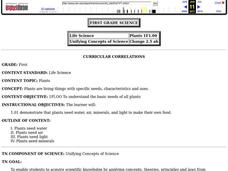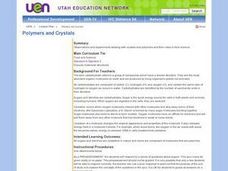Curated OER
The Firebombing of Dresden
In this World War II worksheet, high schoolers read a 1-page selection about the firebombing of Dresden as well as Internet articles about the topic and then respond to 7 short answer questions.
Curated OER
Soil Management
Fourth graders examine different opinions on soil management. In this soil management lesson, 4th graders use a variety of resources to research how agriculture and the environment are related. They investigate cause and effect...
Curated OER
Case of the Missing Pumpkin
Fourth graders explore holidays by participating in a pumpkin activity. In this vegetation lesson, 4th graders discuss the different uses for pumpkins, not just Halloween decorations. Students identify the nutrients pumpkins need to...
Curated OER
Secrets to Healthy Soil
Fourth graders explore needed mineral nutrients for healthy soil. In this soil lesson, 4th graders investigate how living and nonliving elements combine to contribute to fertile soil development.
Curated OER
The Rotten Truth
Fourth graders investigate compost. In this Science instructional activity, 4th graders take notes on the components of soil and its relation to plant growth. Students describe the steps in making compost.
Curated OER
The Soil Chain
Fourth graders show the needs of plants met by soil. In this Science lesson, 4th graders detail the components of soil and determine which are living or once living and non-living. Students determine the needs of plant growth that are...
Curated OER
Vermicomposting
Fourth graders explore insect life by viewing a soil presentation in class. In this composting instructional activity, 4th graders read assigned text about the process of composting soil and the necessity of soil in plant life. Students...
Curated OER
Working Worms
Fourth graders examine earthworms. For this earthworm lesson, 4th graders investigate how earthworms help prepare soil for planting. Students examine other living and nonliving elements in a garden habitat.
Curated OER
Plants
First graders explore the specific needs, characteristics, and uses of plants. They discuss the needs of plants as they grow. Students observe plants in various settings as they grow and note the changes they see.
Curated OER
Good Vibrations
Students demonstrate sound waves and make changes in the waves
resulting in changes in pitch. Students associate changes in pitch in various "musical instruments"with size and shape and the sound waves they produce.
Curated OER
Hail Stone Impact
Sixth graders study the formation of convective storms and test mock hailstones. they graph and analyze collected data.
Curated OER
Facts of Matter
Students make group decisions about matter as they explore and interpret many types.
Curated OER
Physical and Chemical Changes
Eighth graders distinguish between physical and chemical change. For this chemistry lesson, 8th graders observe a series of demonstrations showing physical and chemical changes. They identify the signs that a chemical reaction took place.
Curated OER
Rockets
Students explain the basics of rocketry and explain the relationships between mass, acceleration, and thrust.
Curated OER
Polymers and Crystals
Learners experiment with crystals and polymers and examine their roles in food science.
Curated OER
How Big is a Molecule?
Young scholars estimate the size of a molecule of oleic acid. They conduct an experiment using chalk dust, water, and oleic acid, solve various calculations, and answer discussion questions.
Curated OER
Ride the Wild Leaf Cycle
Fourth graders explore plant life by completing an Internet activity. For this botany lesson, 4th graders identify the types of plants that grow locally and the different soils they utilize to survive. Students read assigned text about...
American Chemical Society
Middle School Chemistry: Chapter 1: Solids, Liquids, and Gases
Five exemplary chemistry lessons about the three states of matter complete with handouts and animations.
Annenberg Foundation
Annenberg Learner: Virtual Particle Lab: Compressibility of Air
Explore the particle model of matter. Run the simulations and see if you can predict the results.





















